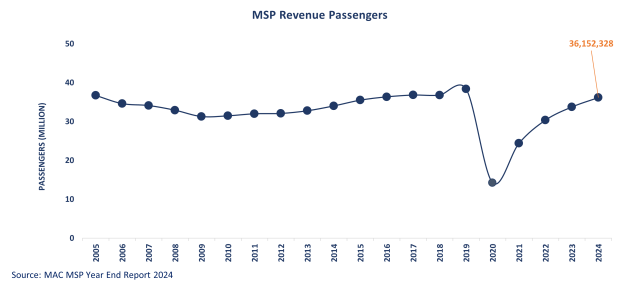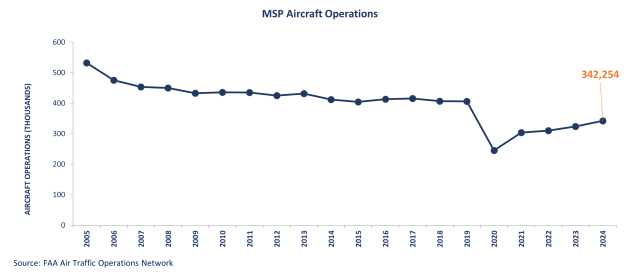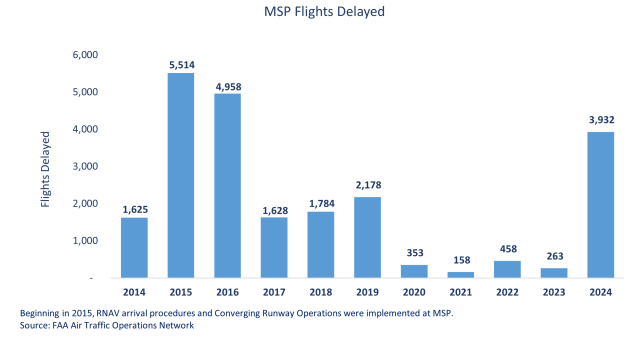Appendix - 2024 Annual Report
This appendix is prepared in accordance with the requirements of Minnesota Statutes Section 473.621. It presents MSP passenger and aircraft operations activity, current airport capacity in terms of operations and passenger enplanements, average length of delay statistics, and technological developments affecting aviation and their effect on operations and capacity at the airport. This appendix also includes the number of operations and based aircraft at each of the MAC’s general aviation airports in 2024 compared with 2023.

Note, this chart reflects numbers of paying, non-charter passengers only. Each year’s totals are greater if revenue charter passengers and non-revenue passengers such as airline employees with flight benefits are included.

Airfield Capacity
Airfield capacity is typically described in terms of hourly capacity and annual capacity under various weather conditions. The table below reflects the hourly capacity for MSP in optimum, marginal and poor weather conditions.

MSP’s current airfield capacity is 160 aircraft operations in optimum conditions. When instrument flight rules are being used due to low-level, heavy cloud cover and/or low visibility, capacity drops to 114 operations.
Airfield Delay
The Federal Aviation Administration (FAA) Air Traffic Operations Network (OPSNET) database counts flights that were reported by Air Traffic Control (ATC) to be delayed for more than 15 minutes. The chart below depicts the annual number of MSP flights delayed by ATC in 2014 through 2024.
The FAA combines arrival and enroute delays into one category, and reports delays for aircraft that accumulate 15 minutes or more holding delay at each facility throughout the entire route of flight. Delays of fewer than 15 minutes are not counted, nor are delays not initiated by ATC.
In 2024, there were 3,932 delayed flights at MSP, which is an increase of 3,669 flights when compared to 2023 (263 delayed flights).
Runway pavement and other maintenance work was completed during the summer of 2024 that closed Runways 12L-30R and 4-22 at MSP from June 3, 2024, through September 21, 2024. With fewer runways available, there was an increase in the number of delayed flights, particularly when weather conditions further restricted runway use. This work is necessary to ensure critical airport infrastructure maintains the highest level of safety for handling aircraft operations and conforms to FAA specifications.

The MAC published a draft MSP 2040 Long-Term Plan (LTP) in May 2024 that assesses future facility needs based on projected passenger and aircraft operation levels over the next 20 years. A component of the LTP is a capacity study. A key determination is that the current runway layout is capable of accommodating projected aircraft operations through 2040 with an acceptable level of delay. The LTP considers potential taxiway and taxilane improvements designed for more efficient aircraft flow between runways and the terminals.
Airfield Delay per Aircraft Operation
When calculating the average delay per flight operation, delay is averaged by each flight’s taxi time and airborne time. The total averaged delay is expressed in minutes of delay per operation. The current industry standard for estimating delay is established by the FAA Aviation System Performance Metrics (ASPM). The FAA uses ASPM results to create performance benchmarks for airports each year. Since 2005, use of ASPM data has been a well-supported methodology to calculate aircraft delays and is accepted by both government and industry as the most valid, accurate and reliable metric.
When compared to other large hub U.S. airports as shown in the table below, MSP ranked 16th with an average delay per aircraft operations of .52 minutes in 2024; in 2023 MSP ranked 40th with an average delay per aircraft operations of .04 minutes.
Technological Developments and Capacity Enhancements at MSP
The FAA continuously explores potential capacity-enhancing development/technology to increase airport efficiency and reduce delay. When advances are identified, efforts are made to implement the technology at the busiest airports. This section describes these efforts as they apply to MSP.
Installation of ASDE-X at MSP was completed in 2009 and provides seamless coverage for complete aircraft identification information. This equipment also allows for future implementation and upgrade to Next Generation (NextGen) navigation technology (Automatic Dependence Surveillance – Broadcast, "ADS-B"); ADS-B uses a Global Navigation Satellite System to broadcast critical information.
In 2024, aircraft operating at MSP were equipped with ADS-B/Cockpit Display of Traffic Information (ADS-B/CDTI) technology per federal policy for aircraft operating in capacity-constrained airspace, at capacity-constrained airports (including MSP) or in any other airspace deemed appropriate by the FAA.
Ongoing Precision Instrument Approach Capabilities
In addition to runway separation and configuration, airfield capacity can be affected greatly by how the runways are equipped for inclement weather. A number of precision instrument approaches continue to be available at MSP as summarized in the table below.

FAA Updating Departure Flight Procedures
The FAA is in the process of upgrading the navigation system used at MSP, and at airports across the country, that determine and manage flight procedures. The FAA is replacing this system with new satellite technology, which includes Area Navigation (RNAV). According to the FAA, updating this technology at MSP, coupled with FAA safety standard changes, requires modifying the flight procedures used by airplanes to depart MSP. The FAA has stated that the updated departure flight procedures will increase safety due to more efficient communications between pilots and air traffic control. The FAA held two public video webinars to discuss the departure procedure updates on August 14 and 15, 2024. The updated procedures are scheduled to go into effect in August 2025. To learn more about the FAA’s project and how the FAA engaged with the public, visit the FAA's website.
MAC’s Reliever Airports
MAC’s six general aviation reliever airports are open for public use 24 hours per day. Aircraft operators must choose an airport at which to base their aircraft. Airports in Minnesota are required to submit a report to the state to the state that identifies the aircraft based at their facilities for 180 days or more. The tables below show the 2023 and 2024 reliever airport operations and reliever airport based aircraft. The operations totals are obtained from the FAA for MAC reliever airports with an air traffic control tower. For the two reliever airports without an air traffic control tower (LVN and 21D), the operations totals are based on data from the MAC Noise and Operations Monitoring System (MACNOMS®).
LVN = Airlake | 21D = Lake Elmo | MIC = Crystal | STP = St. Paul Downtown | FCM = Flying Cloud | ANE = Anoka County-Blaine